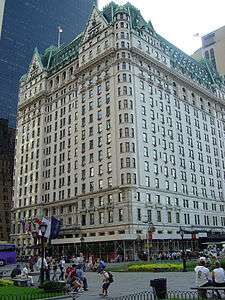Grand Army Plaza (Manhattan)
Coordinates: 40°45′52″N 73°58′24″W / 40.76444°N 73.97333°W

Grand Army Plaza lies between 58th Street and 60th Street, just west of Fifth Avenue and just east of East Drive. It is bisected by Central Park South. The plaza is bounded on the north by Scholars Gate, once one of the two main entrances to the carriage drives of Central Park; bounded on the west by the famed Plaza Hotel; bounded on the south by the Bergdorf Goodman department store, formerly the site of the Cornelius Vanderbilt II House, once one of Fifth Avenue's grandest Gilded Age mansions.
The centerpiece of the plaza's northern half (carved out of the southeastern corner of Central Park), is the equestrian statue of William Tecumseh Sherman sculpted by Augustus Saint-Gaudens,[1] while the principal feature of the plaza's southern half is the Pulitzer Fountain, topped with a bronze statue of the Roman goddess Pomona sculpted by Karl Bitter.
The idea for a unified treatment of the plaza was first proposed by Bitter in 1898. The current layout was designed by Beaux-Arts architecture firm Carrère and Hastings and completed in 1916. The New York City Board of Aldermen named it Grand Army Plaza in 1923 [2] after the Grand Army of the Potomac.[3]
1913 plaza design
The newspaper publisher Joseph Pulitzer died in 1911 having bequeathed $50,000 for the creation of a memorial fountain to be "like those in the Place de la Concorde, Paris, France."[4] In December 1912, the executors of Pulitzer's estate announced that New York City had approved the fountain's proposed location, in the plaza between 58th Street and 60th Street, just west of Fifth Avenue, the same plaza where the equestrian Sherman Monument stood since 1903. The executors invited five architecture firms to participate in a competition to determine the fountain's design, and to provide designs for a "good architectural treatment of the whole plaza." [5] In January 1913, the five schemes were exhibited at the New York Public Library, including the winning scheme, designed by Carrère and Hastings. Architect Thomas Hasting's design placed the fountain in the southern half of the plaza, whereas the Sherman Monument remained in the northern half (but moved fifteen feet west to be symmetrically opposite the fountain). Construction of the new plaza began in 1915, and by November one newspaper reported: "The Pulitzer Fountain...is now finished and bubbling with the purest Croton water," noting that work on the northern portion of the plaza was delayed by subway construction.[6]
1933-1935 restoration
In 1933, Herbert, Joseph and Ralph, sons of Joseph Pulitzer, donated $35,000 for the restoration of the Pulitzer Fountain, to be done under the supervision of architect Dan Everett Waid. The work, delayed by labor troubles, was completed by June 1935.[7] As part of the work, the limestone basin was rebuilt in Italian marble, and the plaza's limestone balustrade and columns that surrounded the fountain were demolished.[8]
1974 Landmarks Designation
On May 30, 1974, the Landmarks Preservation Commission held a public hearing to consider designation of the Grand Army Plaza, including the Pulitzer Fountain and the Sherman Monument, as a Scenic Landmark. The measure was approved on July 23, 1974. [9]
1985-1990 Restoration
On March 26, 1985, the Central Park Conservancy and the architecture firm of Buttrick White & Burtis presented plans to the Landmarks Preservation Commission for a full restoration of the plaza, including the Pulitzer Fountain. The plans called for the restoration of the balustrade and columns removed in the 1935 repairs.[10] The work was completed in June 1990, including a reconstruction of the fountain, this time in granite. Plans to restore the balustrade and columns were abandoned on account of costs. According to The New York Times: "For years this fountain merely dripped and dribbled, but now it cascades, and that makes all the difference, for now the Pulitzer Fountain has a sound."[11] The restoration work included a re-gilding of the Sherman Monument.[12]
2013 Restoration
The plaza was renewed again in 2013, including a re-gilding of the statue of William Tecumseh Sherman.[13]
Historical Gallery
.jpg) 1863 design showing a proposed fountain (before the plaza was extended south to 58th Street).
1863 design showing a proposed fountain (before the plaza was extended south to 58th Street)..jpg) 1868 Map of Central Park illustrates the expanded plaza.
1868 Map of Central Park illustrates the expanded plaza._New_York_City_-_Geographicus_-_CentralParkSW-centralpark-1869.jpg) 1869 map of the plaza, showing a proposed monument where the Pulitzer Fountain was eventually built.
1869 map of the plaza, showing a proposed monument where the Pulitzer Fountain was eventually built. Thomas Hasting's 1913 plaza plan, with the Sherman Monument in the northern (upper) half, and the Pulitzer Fountain in the southern (lower) half.
Thomas Hasting's 1913 plaza plan, with the Sherman Monument in the northern (upper) half, and the Pulitzer Fountain in the southern (lower) half. Aerial View of Grand Army Plaza about 1920.
Aerial View of Grand Army Plaza about 1920.
References
- ↑ Central Park Conservancy Grand Army Plaza
- ↑ Landmark Preservation Commission (23 July 1974). "LP-0860" (PDF). NYC Landmark Designation Reports. Retrieved 12 March 2012.
- ↑ "Grand Army Plaza". centralparknyc.org. Central Park Conservancy. Retrieved 12 March 2012.
- ↑ Landmark Preservation Commission (23 July 1974). "LP-0860" (PDF). NYC Landmark Designation Reports. Retrieved 12 March 2012.
- ↑ The New York Times, December 22, 1912.
- ↑ Chicago Daily Tribune, November 7, 1915.
- ↑ The New York Times, June 14, 1935.
- ↑ The New York Times, May 8, 1935.
- ↑ Landmark Preservation Commission (23 July 1974). "LP-0860" (PDF). NYC Landmark Designation Reports. Retrieved 12 March 2012.
- ↑ The New York Times, March 27, 1985
- ↑ The New York Times, June 28, 1990
- ↑ The New York Times, June 28, 1990
- ↑ Dunlap, David (18 June 2013). "It's General Sherman's Time to Shine, but Not Too Much". The New York Times. Retrieved 19 May 2014.